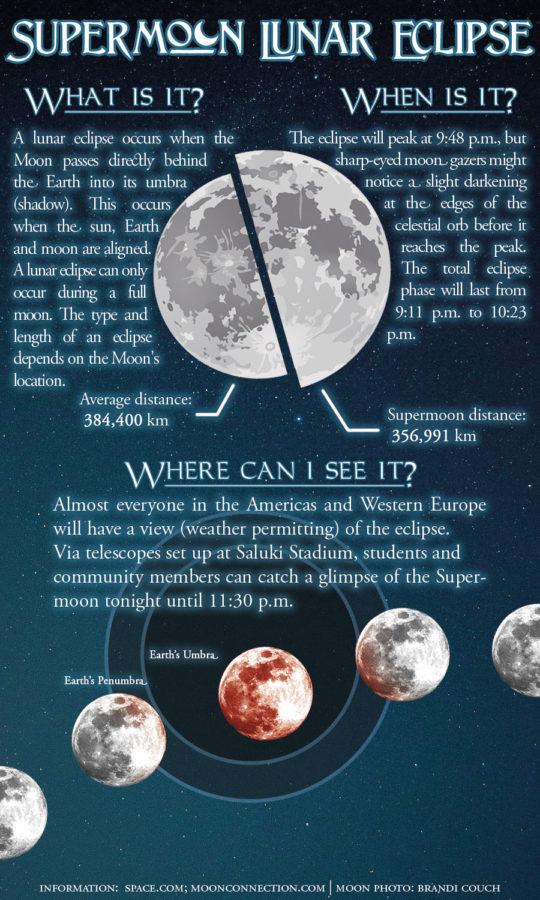There’s a blood moon rising
September 27, 2015
In a total eclipse of the moon, tonight’s sky will turn into a spectacle for all.
The Physics Department will host a public viewing party from 7:30-11:30 p.m. tonight at Saluki Stadium.
The eclipse will begin at 8:07 p.m., with the total eclipse phase lasting from 9:11-10:23 p.m.
Advertisement
The peak is expected to occur at 9:48 p.m.
A lunar eclipse occurs when the sun, Earth and moon align with Earth in the middle.
Bob Baer, head of the Physics Department, said the shadow of Earth will slowly stretch across the moon, making it appear as if the moon has a bite taken out of it.
“You get to see the moon go through all of its phases in one night,” Baer said. “Normally it takes a month, or 28 days, for that to happen, but it’s going to happen in three hours.”
This eclipse is known as a blood moon because the shadow of Earth completely covers it causing the sunlight to bend, giving the moon a deep red color, according to Baer.
April Hendley, a professor in the physics department, said a supermoon occurs during the full moon phase when the moon is at its closest point to Earth, making the moon appear larger.
Baer said about four to six supermoons occur each year, while Hendley said this will be the fourth lunar eclipse in the past two years, a rare combination. According to NASA, a supermoon lunar eclipse has not occurred since 1982, and will not again until 2033.
Advertisement*
Baer said Saturn, the Ring Nebula and Andromeda Galaxy will also be viewable with a telescope.
The Carbondale Science Center and the Astronomical Association of Southern Illinois are also hosting the event, which will include family-friendly science demos and provide volunteers.
Baer said telescopes for individual viewing will be set up and expects the largest lens to be between eight and 10 inches.
Adaptors that allow cell phone cameras to take images from the telescope will be provided by the physics department and the films “Chasing Pluto” and “Apollo 13” will be shown.
Baer said tonight’s event is practice for the total solar eclipse that will occur Aug. 21st, 2017 on the first day of class of the fall semester.
During the eclipse, Carbondale will experience almost two and a half minutes of darkness.
“It’s bizarre,” Baer said. “It’ll be relatively dark out … You’ll be able to see some of the brighter stars.”
Baer expects the 2017 event to draw 30 to 50 thousand extra people to SIUC campus. Carbondale will be six miles north of the point of greatest duration of the eclipse.
“That’s a big one,” Baer said. “That’ll make the lunar eclipse look like a little sideshow.”
The Physics Department will host an observation on the Neckers observation deck on Oct. 11, and a meteor shower viewing on Dec. 13 and 14 at SIU Farms. A full listing of observations is available on the Physics Department’s website.
Cory Ray can be reached at [email protected] or on Twitter at coryray_DE
Advertisement









